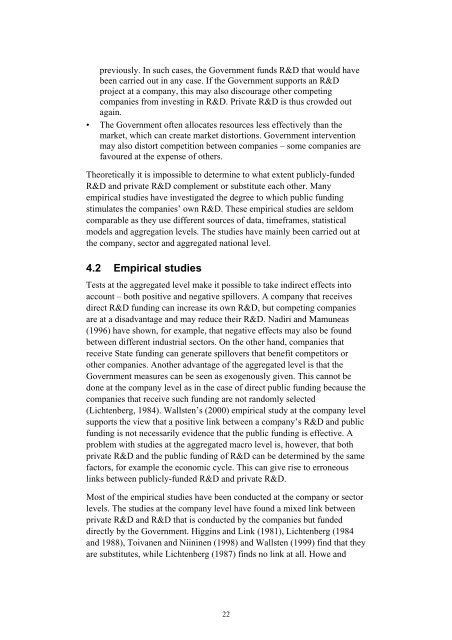Growth through Research and Development - what does ... - Vinnova
Growth through Research and Development - what does ... - Vinnova
Growth through Research and Development - what does ... - Vinnova
You also want an ePaper? Increase the reach of your titles
YUMPU automatically turns print PDFs into web optimized ePapers that Google loves.
previously. In such cases, the Government funds R&D that would havebeen carried out in any case. If the Government supports an R&Dproject at a company, this may also discourage other competingcompanies from investing in R&D. Private R&D is thus crowded outagain.• The Government often allocates resources less effectively than themarket, which can create market distortions. Government interventionmay also distort competition between companies – some companies arefavoured at the expense of others.Theoretically it is impossible to determine to <strong>what</strong> extent publicly-fundedR&D <strong>and</strong> private R&D complement or substitute each other. Manyempirical studies have investigated the degree to which public fundingstimulates the companies’ own R&D. These empirical studies are seldomcomparable as they use different sources of data, timeframes, statisticalmodels <strong>and</strong> aggregation levels. The studies have mainly been carried out atthe company, sector <strong>and</strong> aggregated national level.4.2 Empirical studiesTests at the aggregated level make it possible to take indirect effects intoaccount – both positive <strong>and</strong> negative spillovers. A company that receivesdirect R&D funding can increase its own R&D, but competing companiesare at a disadvantage <strong>and</strong> may reduce their R&D. Nadiri <strong>and</strong> Mamuneas(1996) have shown, for example, that negative effects may also be foundbetween different industrial sectors. On the other h<strong>and</strong>, companies thatreceive State funding can generate spillovers that benefit competitors orother companies. Another advantage of the aggregated level is that theGovernment measures can be seen as exogenously given. This cannot bedone at the company level as in the case of direct public funding because thecompanies that receive such funding are not r<strong>and</strong>omly selected(Lichtenberg, 1984). Wallsten’s (2000) empirical study at the company levelsupports the view that a positive link between a company’s R&D <strong>and</strong> publicfunding is not necessarily evidence that the public funding is effective. Aproblem with studies at the aggregated macro level is, however, that bothprivate R&D <strong>and</strong> the public funding of R&D can be determined by the samefactors, for example the economic cycle. This can give rise to erroneouslinks between publicly-funded R&D <strong>and</strong> private R&D.Most of the empirical studies have been conducted at the company or sectorlevels. The studies at the company level have found a mixed link betweenprivate R&D <strong>and</strong> R&D that is conducted by the companies but fundeddirectly by the Government. Higgins <strong>and</strong> Link (1981), Lichtenberg (1984<strong>and</strong> 1988), Toivanen <strong>and</strong> Niininen (1998) <strong>and</strong> Wallsten (1999) find that theyare substitutes, while Lichtenberg (1987) finds no link at all. Howe <strong>and</strong>22
















